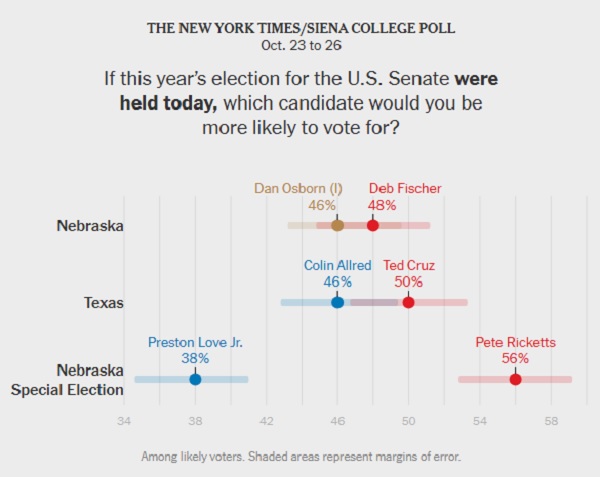Ad Blocker Detected
Our website is made possible by displaying online advertisements to our visitors. Please consider supporting us by disabling your ad blocker.
Republicans Hold Slim Leads in Nebraska and Texas Senate Races
Republicans Hold Slim Leads in Nebraska and Texas Senate Races. Senate contests in Texas and Nebraska, two states that tend to vote Republican, are closer than anticipated as Election Day approaches. The Republican candidates are leading by a tiny margin, which reflects a widely split electorate on topics like immigration, healthcare, and the economy. Given that Senate control may depend on the result, both parties are making significant investments in these contests. Here is a detailed analysis of the factors influencing these contests, the main concerns influencing voters, and the strategies being used by each campaign to win in the closing days.

Nebraska: GOP’s Hold on Cornhusker State Faces Economic Pressure
Although the GOP has historically won most statewide races in Nebraska, the Senate contest this year is closer than typical. Conservative rural voters, farmers, and those concerned about the effects of inflation on daily life are responding favorably to the Republican candidate’s primary economic focus. Rising input costs and trade issues have severely impacted Nebraska’s agriculture-based economy, which is why the Republican campaign has placed a strong emphasis on tax breaks, support for agricultural subsidies, and free-market policies meant to boost rural economies.
Key Issues in Nebraska:
- The Economy and Inflation: Nebraskans are feeling the impact of inflation on everything from groceries to farm supplies. The Republican candidate is highlighting policies to reduce taxes and strengthen the state’s agricultural industry. By promising a reduction in government regulation and championing energy independence, they aim to reassure voters who are worried about their wallets.
- Healthcare Access: While the economy is the primary focus, healthcare is a close second. The Democratic candidate has gained traction by focusing on healthcare reform, specifically calling for Medicaid expansion and policies that make it easier for rural communities to access affordable healthcare. Many in Nebraska’s rural communities face limited healthcare options, which has made this issue more pressing.
- Social Issues and Education: Social issues, including education funding and curriculum debates, have also influenced voters, particularly among suburban and younger voters. The Republican candidate has vowed to prevent what they see as “overreach” in educational policy, opposing federally mandated changes to school curricula. Conversely, the Democratic candidate has promised more funding for public schools and initiatives to make college more affordable, hoping to appeal to a wider, younger demographic.
Campaign Strategies in Nebraska:
Republicans are making significant investments in rural voter turnout through targeted digital advertisements, local campaign events, and agricultural endorsements that center on their central themes of job creation and economic recovery. Additionally, they are strengthening their rural base with recent endorsements from well-known Nebraskans.
Republicans Hold Slim Leads in Nebraska and Texas Senate Races
The Democratic campaign, meanwhile, has doubled down on efforts to reach urban and suburban voters in Lincoln and Omaha. Recognizing that these cities are trending more progressive, the Democratic candidate is emphasizing healthcare, education reform, and a more inclusive economy, hoping to mobilize voters who may not typically participate in midterms. National Democratic leaders have also spotlighted Nebraska in recent weeks, with get-out-the-vote campaigns targeting young and first-time voters, especially in college towns.
Texas: A Battleground for Immigration, Public Safety, and Social Issues
In Texas, the Senate race is proving equally competitive. While traditionally a Republican state, Texas has seen shifting demographics, particularly in its growing urban areas. These changes, combined with divisive issues such as immigration, public safety, and education, are making this race far from certain.
Key Issues in Texas:
- Immigration and Border Security: Immigration has become the defining issue in Texas’s Senate race, particularly among conservative voters near the Texas-Mexico border. The Republican candidate has focused extensively on border security, promising to increase law enforcement funding and advocate for stricter immigration controls. Rural areas, where border-related concerns are most pronounced, are backing these policies.
- Public Safety and Crime: Public safety is a core concern across Texas, and the Republican candidate is emphasizing a tough-on-crime approach, calling for more funding for local police departments. Conversely, the Democratic candidate argues that tackling crime requires a balanced approach that includes social services, mental health support, and addressing the root causes of crime. This appeal has resonated particularly well with urban and suburban voters who have different perspectives on public safety.
- Education and Social Policies: Texas is also experiencing cultural shifts, especially in metropolitan areas like Houston, Dallas, and Austin. The Democratic candidate has gained ground by addressing issues that appeal to younger and more diverse demographics, including support for increased public school funding and reproductive rights. These stances have energized urban voters, especially younger ones, and are widening the Democratic base in cities that have become more liberal over the past decade.
Campaign Strategies in Texas:
Republicans are pouring resources into rural and suburban areas, using their campaign’s final push to drive voter turnout in smaller towns where their policies are more popular. They’re also focusing on persuading undecided suburban voters, emphasizing the need for a strong stance on border security and conservative family values.
Democrats, meanwhile, are focusing on mobilizing the state’s urban and young voters. With heavy digital ad buys, campus outreach, and rallies featuring high-profile figures, they’re hoping to increase turnout among first-time and minority voters. Texas Democrats are also investing in bilingual advertising to reach the state’s significant Latino population, a demographic they hope will turn out in large numbers.
National Implications and What’s at Stake
These two races hold significant national implications, as both parties vie for control of the Senate. Republicans are fighting hard to keep Nebraska and Texas in their column, knowing that losing even one seat could jeopardize their standing. Democrats see an opportunity, albeit slim, to expand their presence in traditionally conservative states, driven by shifting voter demographics and issue-based appeals.
As the final days before Election Day tick down, both parties are doubling their efforts, with national organizations pouring millions into these battlegrounds. High-profile endorsements, last-minute rallies, and a relentless focus on voter turnout are all part of the final push, reflecting just how much is at stake.
What to Watch on Election Night
As Election Day draws closer, here are some key indicators to watch:
Voter Turnout in Urban Areas: High turnout in cities like Omaha in Nebraska and Austin in Texas could benefit Democratic candidates. Urban and suburban voters will play a crucial role in deciding the outcomes in both states.
Rural Vote in Nebraska: If Republicans can maintain strong support in Nebraska’s rural areas, they may have the edge. Nebraska’s agriculture-based economy makes the rural vote particularly influential.
Also Read: Trump’s Bold Border Strategy
Border Counties in Texas: Texas’s border counties, which are directly impacted by immigration issues, will be an important bellwether. If Republican candidates perform well in these areas, it may signal a successful push on their immigration messaging.
Conclusion: A Race to the Finish
With Election Day looming, the Senate races in Nebraska and Texas are likely to remain nail-biters. These traditionally red states are facing unexpected competition due to shifting demographics, divisive issues, and the political polarization of today’s electorate. Republicans still hold the edge, but it’s a precarious one that could go either way, especially if Democrats succeed in mobilizing the base they’ve built in urban and suburban areas.
Ultimately, these races are a microcosm of the broader national political landscape, illustrating the importance of local issues, the power of voter mobilization, and the unpredictability of an engaged electorate. As polls close on Election Night, the outcomes of these Senate races will be closely watched as indicators of shifting tides in American politics. Republicans Hold Slim Leads in Nebraska and Texas Senate Races.
How These Polls Were Conducted: A Closer Look at Methodology
Understanding how political polls are conducted provides insight into their reliability, potential biases, and limitations. Polls like those tracking Senate races in Nebraska and Texas use a combination of sampling, weighting, and data collection techniques designed to reflect the views of the broader electorate. Here’s a detailed look at how these polls are typically conducted, from the design phase through the analysis of results.
1. Sampling the Population
The first step in any poll is to select a representative sample of the population. Because it’s impossible to survey every voter, pollsters focus on smaller groups that reflect the demographics of the broader electorate.
- Random Sampling: Pollsters use random sampling to ensure each voter has an equal chance of being selected. Randomization helps avoid bias by preventing any one demographic from being overrepresented.
- Sample Size: Most reliable political polls include between 500 and 1,500 respondents. This sample size is typically large enough to give a reasonably accurate picture of voter sentiment, with a margin of error usually around +/- 3-5%.
- Likely Voters vs. Registered Voters: Many polls focus on “likely voters,” a subset of registered voters who are expected to participate based on factors like voting history. By focusing on likely voters, polls can provide a more accurate prediction of election outcomes.
2. Data Collection Methods
Data collection is a critical phase that determines how effectively a poll reflects real voter sentiment. Several methods are commonly used:
- Telephone Surveys: Traditionally, many polls were conducted over the phone, with calls made to both landlines and cell phones. While still used, this method has limitations, as response rates have declined significantly in recent years.
- Online Surveys: To reach a broader audience, pollsters now frequently use online surveys. These can reach individuals across various demographics and are typically easier and faster to administer than phone surveys. However, internet access and technology comfort can skew results if not properly accounted for.
- In-Person Surveys: Although less common, in-person surveys, often conducted at events or polling places, can provide real-time insights. However, they’re costly and logistically challenging, making them less practical for large-scale polls. Republicans Hold Slim Leads in Nebraska and Texas Senate Races.
3. Question Design and Wording
The way poll questions are phrased can significantly affect responses. Crafting neutral, straightforward questions helps pollsters avoid leading respondents toward a particular answer.
- Clear and Unbiased Language: Good poll questions avoid emotionally charged or complex language, which could influence respondents’ answers. For example, a question about immigration might ask, “Do you support increased border security?” rather than “Do you support policies that some say could reduce crime?”
- Question Order: The sequence in which questions are asked can also affect results. Pollsters pay close attention to question order, ensuring that earlier questions don’t unintentionally sway responses to later ones.
4. Weighting the Data
Even with careful sampling, some demographics might be underrepresented in the final sample, so pollsters adjust the data to better reflect the overall population. This process, known as weighting, ensures that factors like age, gender, race, and education level align with known demographics.
- Adjusting for Demographic Balance: If, for example, young voters are underrepresented in a poll, the responses of young participants may be weighted more heavily to reflect their presence in the population.
- Historical Data and Voting Patterns: Pollsters may also factor in historical data, particularly for likely voters. For example, older voters tend to have higher turnout rates, so their responses may be weighted more to account for likely participation.
5. Analyzing the Results
Once data is collected and weighted, pollsters analyze the results to calculate candidates’ support levels and determine the margin of error.
- Margin of Error: The margin of error indicates the poll’s potential deviation from the actual sentiment of the population. For example, a margin of error of +/- 3% means that, if a candidate is polling at 50%, their actual support could range from 47% to 53%.
- Confidence Intervals: Pollsters often calculate a confidence interval, which estimates how reliable the poll results are. A 95% confidence interval means that if the poll were conducted 100 times, the results would fall within the margin of error 95 times.
6. Limitations of Polling
While polls offer valuable insights, they have limitations:
- Non-Response Bias: Some groups are more likely to participate in polls than others, which can skew results. For example, younger voters are often harder to reach, which can lead to overrepresentation of older demographics.
Republicans Hold Slim Leads in Nebraska and Texas Senate Races
- Timing of the Poll: Polls conducted close to Election Day tend to be more accurate, as they capture the final attitudes of voters. However, early polls can sometimes misrepresent trends as they fluctuate over time.
- Social Desirability Bias: Respondents may answer questions in ways they think are socially acceptable rather than expressing their true views, especially on controversial topics.
Conclusion
By understanding how political polls are conducted, voters and analysts can better interpret what the numbers truly mean. The methodology behind sampling, data collection, weighting, and analysis makes it clear that while polls are powerful tools for gauging public opinion, they aren’t foolproof predictions. The process involves balancing science and art, and even the most rigorously conducted polls are still estimates, shaped by ever-changing social dynamics and individual behaviors. As election season progresses, interpreting polls with a critical eye allows for a more nuanced understanding of the electorate’s mindset.

